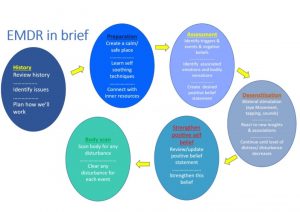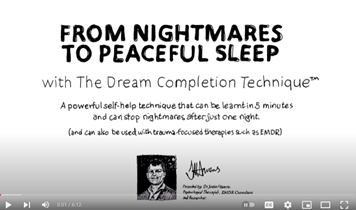EMDR stands for ‘Eye Movement Desensitisation and Reprocessing’.
It was discovered accidentally by Francine Shapiro Phd as she was walking in a park in the late 1980s. As she was walking, She noticed that some distressing feelings she was having about a particular situation suddenly ceased. When she reflected back on what happened, she remembered that she had experienced some spontaneous eye movements (kind of rapid blinking). This led her to experiment further and discover that when thinking and talking about a memory at the same time as stimulating both sides of the brain eg by following hand movements from side to side with the eyes, the distressing memory seems to become less distressing in a long-term way.
Eye Movement Desensitization and Reprocessing (EMDR) therapy is an evidence-based treatment that is used to relieve emotional distress, trauma and pain from the mind and body.
Often, when someone is involved in a distressing or traumatic event, the memory seems to get locked in the nervous system with the original picture, sounds, thoughts, feelings and so on. The brain seems to be overwhelmed and unable to process the experience like a normal memory.
Since the experience is locked there, it continues to be triggered whenever a reminder comes up. It can be the basis for a lot of discomfort and sometimes a lot of negative emotions such as fear and helplessness that we can’t seem to control.
These are really the emotions connected with the old experience that are being triggered.
In EMDR, alternating left-right- bilateral stimulation of the brain with eye movements or sounds or taps is used.
These seem to unlock the nervous system and allow the brain to process the experience. This is similar to what happens in REM or dream sleep: the eye movements may be involved in processing the unconscious material.
Disturbing events can be stored in the brain in an isolated memory network. This prevents learning from taking place. The old material just keeps getting triggered over and over again.
In another part of your brain, in a separate network, is most of the information you need to resolve it. It’s just prevented from linking up to the old stuff. Once processing starts with EMDR, the two networks can link up. New information can come to mind and resolve old problems.
In successful EMDR therapy, the meaning of painful events is transformed on an emotional level. For instance, a rape victim shifts from feeling horror and self-disgust to holding the firm belief that, “I survived it and I am strong.”










